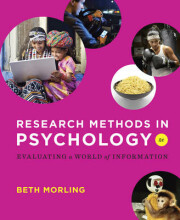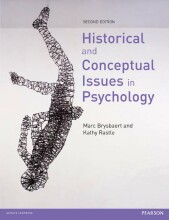Summary: Current Topics; From Theory To The Clinic.
- This + 400k other summaries
- A unique study and practice tool
- Never study anything twice again
- Get the grades you hope for
- 100% sure, 100% understanding
Read the summary and the most important questions on Current topics; From theory to the clinic.
-
1 College 1
This is a preview. There are 1 more flashcards available for chapter 1
Show more cards here -
What is the difference between independen, and dependent variables?
- Independent variables are variables that you manipulate in an experiment.
- dependent variables are the variables you measure before and after the manipulation of the independent variables.
-
How can consciousness be defined according to Thomas Nagel?
If there is something it is like to be an animal, i.e. a bat (or a computer or baby) then that “thing” is conscious. Otherwise it is not. -
Why is consciousness such a difficult topic to research?
- For long the question of consciousness lay outside the boundaries of normal science.
- it was seen as a Fuzzy, ill-defined domain whose subjectivity put it forever beyond the reach of objective experimentation.
- in current days, consciousness has become a more popular research topic, although we're still struggling with questions like;
- Can modern cognitive neuroscience turn this age-old philosophical problem into an experimental question?
- Is the human mind smart enough to understand it own subjectivity?
-
Describe Daniel Dennett's view on consciousness.
- Dennett is a materialist.
- His point of view is that there is no greater thing that is consciousness besides the combination of output of neurons; “The factory is empty”.
- Consciousness is the product of a mechanism of interacting neurons.
- The hard problem arises from the false intuition that if we have explained perception, memory, attention, language, and all the other details, there still would be something left out –“consciousness itself”
- Dennett is a materialist.
-
Summarize the view on consciousness according to both dualism and materialsm.
- Dualistic ideas about consciousness: themind and body are not identical and consciousness cannot be reduced to pure brain activity
- Materialism:allemergentphenomena, includingconsciousness, are the result of material properties and interactions in the brain.
-
Describe statements about consciousness from this lecture.
Dehaene states that conscious experience is apercept , thought, action or feeling that can be (re)produced or reported about (later more discussion about this)- Consciousness means
subjective experience or phenomenal experience. The way things seem to me, as opposed to how they areobjectively . - consciousness is a
subjective experience of something - consciousness arises from a mechanism of neural activation.
Qualia are individualinstances ofsubjective conscious experience (i.e., pain of a headache, the taste of wine, or the perceivedredness of an evening sky). The 'what it is likeness' of mental states or systems/beings.
-
2 college 2
This is a preview. There are 11 more flashcards available for chapter 2
Show more cards here -
What is a misconception about conscious perception, and what is the way it actually is?
Your conscious perception is a constructionof the senses not and exact replica of the outside world -
What is meant if we say; conscious perception is serial?
- You can only perceive one interpretation of the world at the time.
- For example with this necker cube, you can see the cube standing in two ways but not at the same time only back to back.
- You can only perceive one interpretation of the world at the time.
-
Describe the names of the directions from which you can look at the brain, and the directions of slices you can make.
- Dorsal; top side of the brain
- ventral; bottom side of the brain
- anterior; front of the brain
- posterior; back of the brain
- medial; towards center of the brain
- lateral; towards the outside of the brain.
- axial plane; horizontal
sliceing saggital plane; fromanterior to posterior vertical
sliceing - coronal plane; from lateral to lateral vertical
sliceing .
- Dorsal; top side of the brain
-
Describe blindsight as a neurological condition.
Blindsight is caused by damage to theoccipital lobe.- the
severity of the damage indicates the size of the visual field that isobstructed . - Patients insist on not having any visual sensation in their blind parts of the visual field.
howe ver, under forced guessing, patients score above change when;
discriminating shapes, orientation, and colour- reaching for objects accurately
positioning their hands accurately for grasping objectshaving accurate perception for direction of motion.
- Higher grades + faster learning
- Never study anything twice
- 100% sure, 100% understanding
































